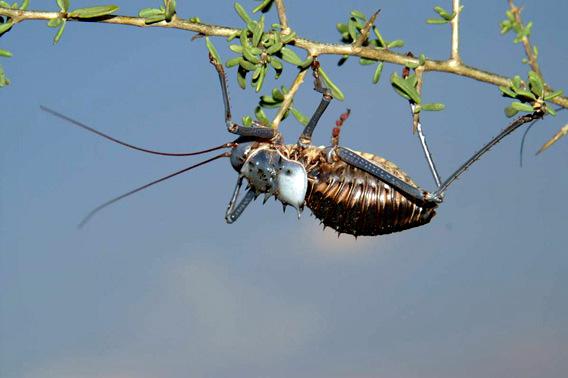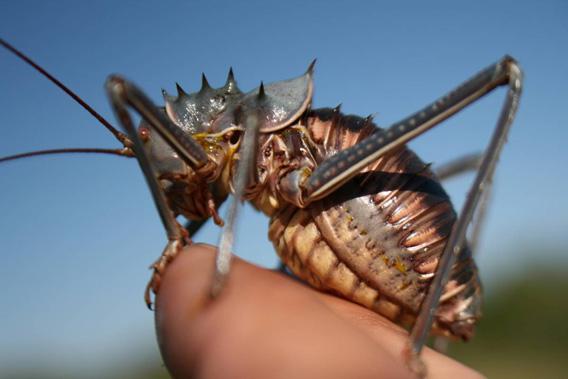It’s time. Time for their glittering armor and their orgiastic cannibalism, their rhythmically gyrating jazz-antennas and their fearsomely acrobatic, get-Hugh-Hefner-his-smelling-salts sex. Time for the stinking green blood they squeeze from their joints, and the weaponized vomit they smear over their bodies.
What it’s time for, as autumn approaches in the Kalahari, is the armored ground cricket. Never heard of it? That’s hardly surprising. These little lookers haven’t generally made the A-list of African wildlife at which generations of Roosevelts and Hemingways have aimed their elephant guns and Leicas. But if armored ground crickets face some rather formidable marketing challenges, they’re also ridiculously, absurdly fascinating.
Like many visitors to southern Africa, my three fellow road-trippers and I first ran across these crickets literally. As in, with a car. Crunch. Well—crunch—more than one. Crunch, crunch. Woops. Crunch. Watch it there, little fellas! Crunch crunch crunch crunch crunch. All this before we’d left the parking lot of a lodge south of Windhoek (the capital of Namibia, a country that despite any recently amplified cricket-related anxieties should be at the top of every African travel itinerary).
We pulled onto the open road and this drumbeat of crunching death accelerated to a blood-curdling, Jiffy-Pop pace. Utterly revolted, we pulled over almost immediately and turned off the ignition. Wandering into the silence of the windswept highway, we came face-to-spiny-face with our victims: fat, bristling with eponymous armor, and about two inches long, plus antennas.
Hideously mangled by an earlier car, one cricket—let’s call him, oh, Chester, shall we?—struggled mightily, and with much antenna-waving, to right himself. We paused for a moment of obligatory liberal-arts-grad reflection on the trail of casual destruction that even the best-intentioned among us will leave in the world. Meanwhile, other crickets ambled over and stood in a somber arc around the grievously wounded Chester. Heads bowed, jazz antennas momentarily subdued, they seemed—somehow—to share the somber moment. Then they all, simultaneously, began to eat Chester alive.
Our shock and their meal were interrupted by the appearance of that rare Namibian beast—another car. We jumped aside and watched this vehicle flatten what remained of Chester and everyone else at his family-style dinner party. Soon, more crickets clambered over to feast on the dead and the undead-but-too-injured-to-flee. What we were watching was the genesis of a cricket pancake—a continually growing road-pie of “spikes and spines and waving legs in a welter of gooey blood,” as Bill Bateman describes it. Bateman is a behavioral ecologist at the University of Pretoria in South Africa who, though he’s studied rhinos, hyenas, and kangaroos, keeps a special place in his heart for ground crickets. He first encountered “their long solemn faces and gently waving antennae” as he watched them rip a beetle to pieces on a South African dune. “I fell in love immediately.”
The cricket road pies, which spread like oil patches across Namibia’s highways, result not just from the crickets’ penchant for roadside dining but from their extraordinary numbers. Park yourself on a chair outside, wait a few minutes, look over your shoulder, and you’ll likely see an armored ground cricket climbing steadily toward your neck to give you a friendly antenna-tickle. Walking isn’t any safer (not least for the crickets). Every 10th step you take will end with a sickening crunch underfoot.
The downside of ground crickets—aside from blood- and antenna-caked Reeboks—is that their general repellence makes it hard to appreciate the brilliance of the species’ adaptations. (There are actually a number of species, and we apparently saw the flagship model, Acanthoplus discoidalis.) But in fact it’s their vividly noxious behavior that makes them so interesting to scientists.
Take the cannibalism. We never saw the crickets eat anything but one another. Nor did we ever see anything eat crickets, except other crickets. This, we joked, was perfection: the biological equivalent of a perpetual motion machine.
But crickets do eat other things, such as flowers and wild grasses. They also eat baby birds, although sometimes they just eat the bills off. And crickets eat crops, particularly the sorghum and millet that are staples of southern African diets.
When the cricket population peaks and food runs out, the crickets start to swarm—a group march in search of fairer pastures. The crickets are desperately seeking protein and salt. When you’re walking a lot—these crickets can’t fly—you’re going to get the munchies, and what’s saltier, more protein-filled, or more convenient than a nearby colleague? The ethos of the swarm, according to Bateman, is that of the French Foreign Legion: “marche ou crève” (march or die). Each cricket’s hind legs are “literally being nipped at from behind.” If you’re not on the move, you’re on the menu.
This swarming behavior is of particular interest to scientists as the Earth warms. For one thing, new rainfall patterns may change or expand the areas of southern Africa where ground crickets swarm. More generally, ground cricket swarming is considered similar to that of flying locusts, which are far more destructive to crops but much more difficult to study. Armored ground crickets move slowly, on the ground, and their swarms are smaller, so they’re good models of desperate mass migration. If global warming means more locust-fueled destruction, then an accurate understanding of the weirdness of swarming will become ever more important.
It turns out the other half of our cricket gallows humor—that nothing eats ground crickets, except other crickets—isn’t accurate either. Some foxes eat them; some birds, too. But lots of hungry creatures won’t touch them. One of the most remarkable characteristics of armored ground crickets is the array of defensive measures they deploy against potential predators.

Photo by Philip Bateman
Some measures are simple: They’re as well-armored as their name suggests, and their bite is strong enough to draw human blood (though in my experience they seemed pretty bored by people, aside from wanting to climb up your shoulder and fondle your neck). Ground crickets also make a noise—a “disturbance stridulation”—either to scare off predators or remind them of exactly what they’re about to mess with.
And mess is the right word. If you really piss off a ground cricket, it’ll squeeze yellowish-to-green blood out of seams in its body, or even squirt it, a tactic known as autohemorrhaging. The blood stinks, and predators seem to despise it. Bateman once watched an African wild cat tossing a ground cricket up in the air repeatedly, trying to decide if it was good to eat. The cricket “autohemorrhaged on the cat’s paws and the cat went off, tail lashing and flicking its paws with distaste.”
After autohemorrhaging, by the way, crickets have the good sense to furiously clean themselves off—“No! Really, I’m fine! Nothing to see here!”—lest other crickets interpret blood as an invitation to dinner. If blood doesn’t repel an attack, there’s always vomit. Crickets will cover themselves in their own sick.
If you’re fat and flightless, you’re going to want just such DEFCON 1-caliber preparations, especially in the harsh Kalahari. But the real lesson of the ground crickets’ arsenal isn’t how weird their defenses are. It’s the wide range of tactics. According to Bateman, armored ground crickets demonstrate the “additive” advantage of an arsenal of different methods. These tactics can be deployed selectively against different predators, or progressively against a single predator as an attack gets more serious.
The love life of ground crickets, too, holds lessons for scientists, though it’s hard not to get bogged down in details like their (the crickets,’ not the scientists’) penchant for two or so hours of slow, late-evening lovemaking (hanging from a branch; she’s on top), the formal serenade and antenna-caressing that precedes it, male crickets’ preference for skinny, young virgins, or the fact that females are ready to go again in 12 hours, while males, who as Bateman describes it stagger off “considerably reduced and shriveled,” need more than a day to recover.
What’s fascinating, scientifically, about cricket love is that the usual direction of “fussiness” is reversed. In many species, the numerical disparity between sperm and eggs means that females have every reason to be extremely choosy about their partners, while males might as well mate as widely as they can. But armored ground crickets reverse this dynamic. The guys are the picky ones.
Why? Probably because male crickets give female crickets an enormous “nuptial gift.” Cash? A yacht? Or something even Donald Trump’s secretary wouldn’t think of: a spermatophylax. That’s a large package of food that accompanies the ampulla (the sperm-containing vessel). The ampulla is attached externally to the female’s genital opening, but she can remove it whenever she wants. The spermatophylax—chocolates? For me?!—is attached to the ampulla and encourages the female to leave the ampulla in place while she’s eating. But it’s a big gift—perhaps 20 percent of the male’s body weight—and hence a big investment. So male ground crickets will pick carefully among females, refusing to mate until they find a suitable partner.
I recently shared the ins and outs of cricket courtship with Helen, a fellow Namibia traveller whose revulsion at ground crickets is untarnished by either scientific considerations or sympathetic anthropomorphizations.
“Actually,” I told Helen, “you won’t believe this, but male crickets give female crickets a gift—a really big gift—of food.” “Yeah,” she replied. “Himself!” “And anyway,” she added, after my way-too-much-information description of the spermatophylax, “that sounds like prostitution.”
Sigh. Her cynicism is not misplaced: In a cricket-eat-cricket world, bringing your date the equivalent of a 40-pound Whitman’s Sampler looks less like the Kalahari equivalent of high Victorian manners and more like garden-variety common sense. But I can still manage some sympathy for the little critters my rental car and I massacred by the untold thousands. In a famously tough neighborhood, they’re simply trying to find love and feed (on) their families. Those “give ‘em a brake!” signs that warn motorists about construction workers come to mind: Ground crickets, it seems, can’t catch one either.
